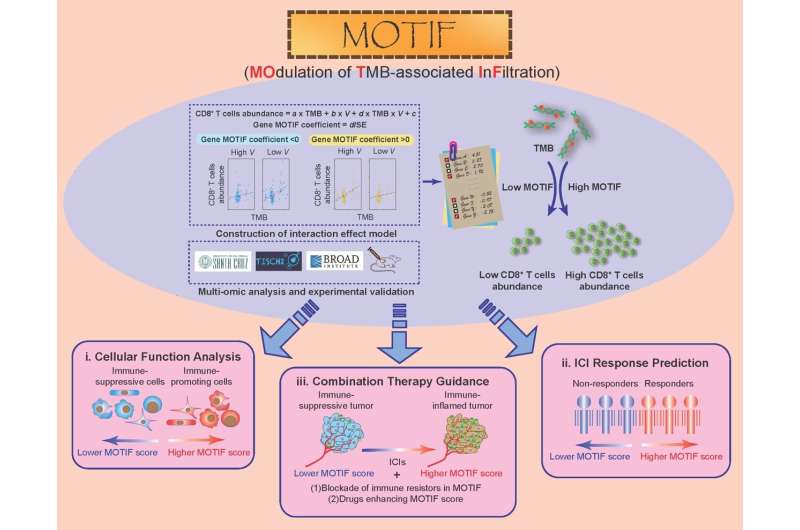This article has been reviewed according to Science X's editorial process and policies. Editors have highlighted the following attributes while ensuring the content's credibility:
fact-checked
trusted source
proofread
Predicting immunotherapy response and guiding combination therapy with MOTIF

Tumor mutation burden (TMB) is considered an important predictive biomarker for the efficacy of immunotherapy. However, in cancer types where TMB is not positively correlated with the abundance of CD8+ T cells, TMB cannot predict the efficacy of immunotherapy.
This suggests that tumors with high immunogenicity do not always result in an immune-inflammatory microenvironment phenotype. The barrier between TMB and immune infiltration, as the initial and effector stages of the cancer-immune cycle, requires further exploration of the mechanisms underlying the differences in immune infiltration caused by the same level of TMB.
New targets for immunotherapy resistance and combined enhancement approaches based on this urgently need to be discovered and proposed.
In a study published in the journal Science Bulletin, researchers have developed a Modulator of TMB-Associated Immune Infiltration (MOTIF) with transcriptome sequencing data from a total of 9,311 tumor samples across 30 cancer types. Then, researchers were convinced that MOTIF elucidates both positive and negative regulatory factors of the cancer-immune cycle. It also elucidates the regulatory factors of immune cell chemotaxis, infiltration, and exclusion.
Tumor cell MOTIF scores elucidate their functional heterogeneity. The close relationship between MOTIF scores in stromal cells and immune cells and their microenvironmental functions is highlighted. MOTIF elucidates the heterogeneity of interactions between various cell components and CD8+ T cells in the microenvironment.
Meanwhile, MOTIF elucidates the close relationship between tumor cell functional heterogeneity and various cell components in the microenvironment. High MOTIF scores in various types of cells in the microenvironment are significantly positively correlated with the response of patients to immunotherapy.
Compared to TMB, MOTIF reflects the level of CD8+ T cell infiltration in patients more accurately. MOTIF predicts immune infiltration regardless of mutation type and copy number variation. MOTIF predicts the abundance of pro-inflammatory immune cells and various stages of the cancer-immune cycle. Patients with high MOTIF scores have a higher immunotherapy response rate. The combination of MOTIF with TIDE and TIGS increases the predictive efficiency of immunotherapy efficacy.
Based on MOTIF, EMC3 is screened as a negative regulatory factor for immune infiltration highly expressed in tumor cells. Knocking down tumor cell EMC3 is validated to enhance immunotherapy in subcutaneous tumor models. Additionally, knocking down tumor cell EMC3 enhances immune therapy by increasing microenvironmental CD8+ T cell infiltration. RGES algorithm is also used to screen paclitaxel/docetaxel to increase MOTIF scores.
Paclitaxel/docetaxel combined with immunotherapy enhances efficacy. Paclitaxel/docetaxel enhances immunotherapy by increasing MOTIF scores and promoting microenvironmental CD8+ T cell infiltration and function.
Currently, MOTIF is the first predictive biomarker that comprehensively covers the entire tumor immune cycle process. It also unveils the reasons behind the differential ability of equivalent levels of TMB to induce CD8+ T cell infiltration for the first time.
It helps innovate predictive indicators and sensitization methods for immunotherapy and proposes methods and means to shift the immunosuppressive microenvironment towards an immune-inflammatory phenotype, providing novel guidance, approaches, and insights for the clinical application of immunotherapy.
More information: Zheng-Yu Qian et al, Modulator of TMB-associated immune infiltration (MOTIF) predicts immunotherapy response and guides combination therapy, Science Bulletin (2024). DOI: 10.1016/j.scib.2024.01.025



















